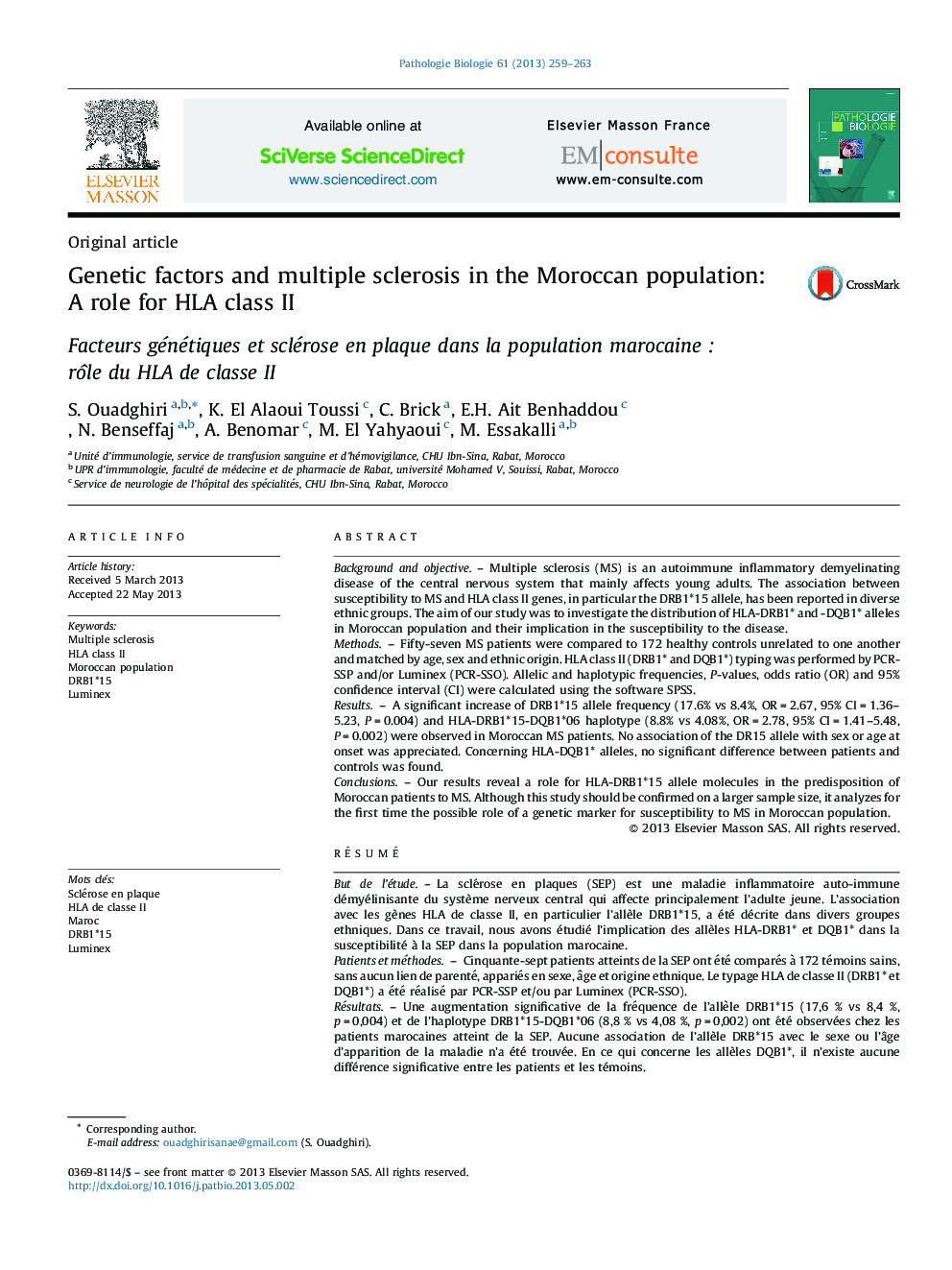| Article ID | Journal | Published Year | Pages | File Type |
|---|---|---|---|---|
| 4136006 | Pathologie Biologie | 2013 | 5 Pages |
Background and objectiveMultiple sclerosis (MS) is an autoimmune inflammatory demyelinating disease of the central nervous system that mainly affects young adults. The association between susceptibility to MS and HLA class II genes, in particular the DRB1*15 allele, has been reported in diverse ethnic groups. The aim of our study was to investigate the distribution of HLA-DRB1* and -DQB1* alleles in Moroccan population and their implication in the susceptibility to the disease.MethodsFifty-seven MS patients were compared to 172 healthy controls unrelated to one another and matched by age, sex and ethnic origin. HLA class II (DRB1* and DQB1*) typing was performed by PCR-SSP and/or Luminex (PCR-SSO). Allelic and haplotypic frequencies, P-values, odds ratio (OR) and 95% confidence interval (CI) were calculated using the software SPSS.ResultsA significant increase of DRB1*15 allele frequency (17.6% vs 8.4%, OR = 2.67, 95% CI = 1.36–5.23, P = 0.004) and HLA-DRB1*15-DQB1*06 haplotype (8.8% vs 4.08%, OR = 2.78, 95% CI = 1.41–5.48, P = 0.002) were observed in Moroccan MS patients. No association of the DR15 allele with sex or age at onset was appreciated. Concerning HLA-DQB1* alleles, no significant difference between patients and controls was found.ConclusionsOur results reveal a role for HLA-DRB1*15 allele molecules in the predisposition of Moroccan patients to MS. Although this study should be confirmed on a larger sample size, it analyzes for the first time the possible role of a genetic marker for susceptibility to MS in Moroccan population.
RésuméBut de l’étudeLa sclérose en plaques (SEP) est une maladie inflammatoire auto-immune démyélinisante du système nerveux central qui affecte principalement l’adulte jeune. L’association avec les gènes HLA de classe II, en particulier l’allèle DRB1*15, a été décrite dans divers groupes ethniques. Dans ce travail, nous avons étudié l’implication des allèles HLA-DRB1* et DQB1* dans la susceptibilité à la SEP dans la population marocaine.Patients et méthodesCinquante-sept patients atteints de la SEP ont été comparés à 172 témoins sains, sans aucun lien de parenté, appariés en sexe, âge et origine ethnique. Le typage HLA de classe II (DRB1* et DQB1*) a été réalisé par PCR-SSP et/ou par Luminex (PCR-SSO).RésultatsUne augmentation significative de la fréquence de l’allèle DRB1*15 (17,6 % vs 8,4 %, p = 0,004) et de l’haplotype DRB1*15-DQB1*06 (8,8 % vs 4,08 %, p = 0,002) ont été observées chez les patients marocaines atteint de la SEP. Aucune association de l’allèle DRB*15 avec le sexe ou l’âge d’apparition de la maladie n’a été trouvée. En ce qui concerne les allèles DQB1*, il n’existe aucune différence significative entre les patients et les témoins.ConclusionsNos résultats confirment un rôle de l’allèle DRB1*15 dans la prédisposition des patients marocains à la SEP. Bien que cette étude doive être confirmée sur un plus grand échantillon, il met en évidence pour la première fois le rôle possible d’un marqueur génétique dans la prédisposition à la SEP dans la population marocaine.
